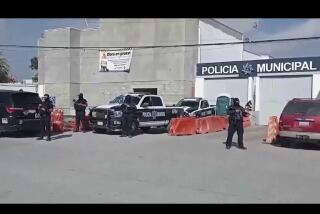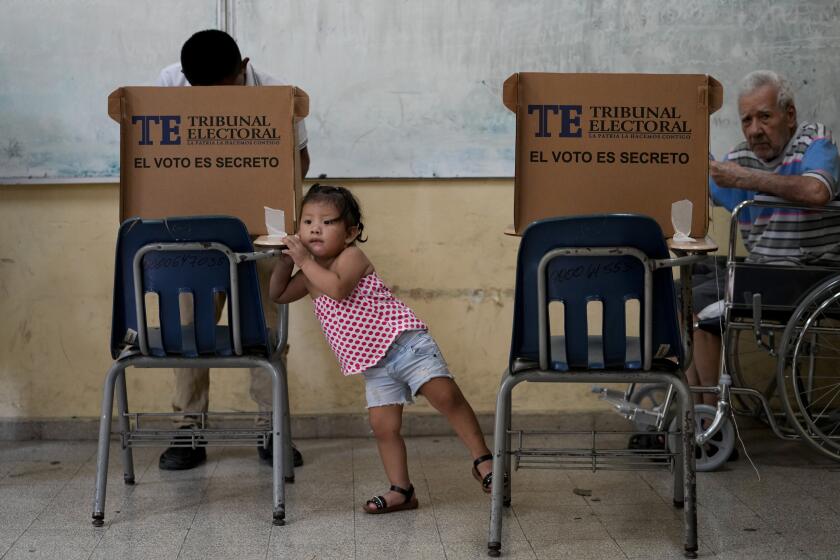A church is reborn
With clarinets, trumpets and tubas, the Oaxacan Echo youth band blasted its raucous music into the ceiling of St. Cecilia Catholic Church in South Los Angeles on a recent Sunday afternoon.
Hector Mata, a Oaxacan immigrant, watched from the wings.
St. Cecilia’s was packed. That’s the way it’s been ever since the church began holding monthly Masses honoring the Virgin of Soledad, patron saint of the Mexican state of Oaxaca.
Mata, 59, helped organize these Masses and subsequently helped resurrect a church.
Standing at Normandie Avenue and 42nd Street, St. Cecilia’s has a congregation made up mostly of Latino immigrants. But Sunday services at the church were as barren as its collection plate when Father Luigi Zanotto arrived a decade ago from Oaxaca.
Zanotto, an energetic 60-year-old Italian priest, was determined to change that by reaching out to a community he knew well. He urged Oaxacan parishioners such as Mata to form their own church groups and arrange their own Masses, and then invited others to follow their lead.
They responded by making the church their own. This included venerating saints, such as the Virgin of Soledad, who were more popular in their native villages. The church is now home to two other saints from Mexico, one each from Guatemala and El Salvador, and another from Nigeria.
St. Cecilia’s was reborn.
Once dependent on subsidies from the Archdiocese of Los Angeles, the church is now self-sustaining. Each of four Spanish-language Sunday Masses attracts hundreds of parishioners. Archbishops, cardinals, bishops and consuls from Africa and Latin America also have visited.
“This church now is the definition of a parish -- which is the communion of communities,” Zanotto said.
Mata, who used to go to church out of obligation in his native country, said he had never known a priest who invited believers to share responsibility for running the church.
Immigrants in Los Angeles often “enclose themselves in their customs and live in their own world,” Mata said. St. Cecilia’s “gave us a great opportunity to . . . open ourselves to the broader world.”
--
St. Cecilia’s congregation was predominantly white when the church opened in 1927. Then in the 1960s, blacks began moving into the neighborhood. By the mid-1990s, they were being replaced by Latino immigrants.
The massive church resembles many in Latin America, with its towering arches, enormous stained-glass windows, marble floors and side altars.
But the new residents were slow to discover St. Cecilia’s, whose clergy remained distant. Church doors were kept locked. The pastor didn’t speak Spanish, and the church’s aging sound system sent the Sunday homily echoing off the concrete walls. Masses rarely topped 200 people, a fraction of the church’s capacity.
Eventually the pastor, realizing that new times required new skills, invited the Combonis, an order of missionary priests, to run St. Cecilia’s.
Zanotto arrived in 1997. He had spent 13 years in Mexico and was fluent in Spanish.
He embraced St. Cecilia’s new neighbors. He unlocked the church and its rectory, and hired a Spanish-speaking secretary. He brought in nuns from Colombia to go door to door, asking residents what they might need. He held annual posadas, a Mexican Christmas celebration.
Then in 2000, Oaxacan immigrants from San Francisco Cajonos approached Zanotto about holding a special party and Mass to raise money for their Mexican village. Among them was Hector Mata.
Since arriving in the United States 42 years ago, Mata had started his own gardening business, learned English, sent two daughters to college and become a citizen. The only part of his life that had not changed was his relationship with the Catholic Church.
Zanotto urged the Oaxacans to arrange the Mass themselves. He told them the church was theirs, but so was the responsibility for organizing and promoting the service.
Zanotto knew Oaxaca. He had served for seven years in an Indian parish in the Oaxacan mountains in the 1970s. He lived in a thatched hut and rode a horse to the remotest of his parish’s 40 villages.
The church anchored the mountain villages, but priests were a rare sight, so native Indians ran their own services. Decisions were made communally, as they had been for centuries. When a priest did arrive, he ran things without input from church members.
Oaxacan villages have “a sense of community that the church is the contradiction of,” Zanotto said.
His experience in Mexico prompted years of reflection on the role of the priest and his parishioners.
The priest, Zanotto came to believe, must put his ego aside and trust his flock to take the church reins. Then, he said, their faith would deepen.
So when Mata and the others came to him, Zanotto asked them to arrange a Mass for all Oaxacans.
After two months of publicity, they organized a Mass attended by 300 people.
Zanotto suggested they form a Oaxacan Catholic church group. They found a painting of the Virgin of Soledad, the work of an immigrant artist in Los Angeles. Zanotto knew of the Virgin’s importance to Oaxacans.
Four churches had previously declined to display the painting, but it was installed at St. Cecilia’s at a December 2001 Mass in her honor. Oaxacans from across Southern California packed the church.
“It’s our mother coming to tell you you are not alone here,” Zanotto told the congregation that day.
With that, St. Cecilia’s became a center for Oaxacan religious life in Los Angeles.
--
Zanotto urged others to follow the Oaxacans’ lead.
A Guatemalan group at the church commissioned a statue of the Black Christ of Esquipulas. The Black Christ is both a national and religious icon for Guatemala and a symbol for Indians from southern Mexico.
Measuring almost 9 feet tall, the black wooden statue of Jesus on the cross was transported across two borders -- without proper documentation identifying it as a replica. It is now known by congregants as the Cristo Mojado.
“The Christ had no papers,” said Guillermo Palencia, an Esquipulas organizer at St. Cecilia’s. “Like many of us, it came across illegally.”
Salvadoran churchgoers commissioned a statue back home of Salvador del Mundo, patron saint of El Salvador, and arranged to have it shipped to Los Angeles.
“We could have had it made here, but we wanted it to be like us, who came from another country,” said Esther Ascencio, a housekeeper and lay leader.
Meanwhile, a community of Igbos, a Nigerian ethnic group, that had been attending the church since 1993, was also flourishing under Zanotto. In 2003, they painted a portrait on a church wall of Iwene Tansi, the first Igbo Catholic priest, who was beatified by Pope John Paul II.
Each saint was given a side altar, and each group of parishioners organized a monthly Mass. Lay leaders took responsibility for fundraising, and planning confirmation and Easter Mass.
Zanotto “gave the opportunity for the lay leaders to know that it is the people in the church that is the church, not the clergy,” said Anthony Ikebudu, an Igbo lay leader.
Zanotto also started a contest for queen of St. Cecilia’s annual fair, with the winners raising the most money. November’s festival raised $52,000.
With tight budgets, Oaxacans, Guatemalan and Salvadorans remodeled the church’s patio, adding tile, new paint, benches and a fountain. Nigerian parishioners paid for the materials.
The church groups also put in a new lighting system and a sound system that eliminated the echo. In 2001, they installed church bells.
By 2003, most Masses were full.
--
Mata, meanwhile, had found a church where “people know me and accept me as I am.”
He marveled at how Zanotto used the Bible to deepen parishioners’ understanding of family or social problems -- unlike priests in Oaxaca.
He devoted more time to St. Cecilia’s. He and the priest became friends -- a new experience for Mata. He had learned to trust his abilities and to be a decision-maker. Now at St. Cecilia’s, he has orchestrated cleanups, supervised the landscaping, helped organize the fair and planned repairs with other lay leaders.
So although the Masses that Mata helped organize looked traditionally Oaxacan, they were more a reflection of the person he had become in the U.S.
“This is the land of opportunities,” he said. “People grow here.”
Other lay leaders, such as Esther Ascencio, also found their faith deepening.
Ascencio, 34, had grown up in a village in El Salvador that was a 40-minute bus ride from the nearest church. She never considered taking an active role. At Mass, the poor sat in back, the wealthy up front.
Ascencio arrived in the United States 18 years ago, joining St. Cecilia’s in the mid-1990s. She took a catechism class from Zanotto, who preached that priests were human beings who made mistakes and sometimes got discouraged.
“Here, we don’t say I’m going to church,” she said. “I am the church.”
But 2003 also turned out to be the year that Zanotto was sent to New Jersey to run a Comboni nonprofit organization.
With Zanotto gone, the church’s new pastor decided to do away with the monthly Masses in honor of each saint. But parishioners resisted. They met with the priest to oppose the change. He left after eight months. Another pastor who has allowed the groups the wide latitude they enjoyed under Zanotto took his place.
That “never would have been possible back home,” Ascencio said.
--
The Mass honoring the Virgin of Soledad ended with the rowdy strains of the Oaxacan Echo youth band.
“It’s like having part of Oaxaca here,” Mata shouted over the music.
As the last Oaxacan parishioners filed out of the church, Nigerian Igbos began arriving for their service.
Men in iboris down to their feet and women in flowing abada dresses and colorful head wraps made their way past Mexican fruit and corn vendors outside.
Zanotto, who still serves in New Jersey, recently returned to visit the church that gave expression to the ideas he formed in the Oaxacan mountains years ago.
St. Cecilia’s showed “how the church could be, must be,” Zanotto said. “Surely this is a school for how to live in the United States.”
--
More to Read
Start your day right
Sign up for Essential California for news, features and recommendations from the L.A. Times and beyond in your inbox six days a week.
You may occasionally receive promotional content from the Los Angeles Times.






